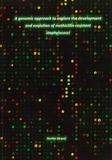A genomic approach to explore the development and evolution of methicillin-resistant staphylococci
Summary
The aim of this thesis was to investigate genomic differences between CA-MRSA and HA-MRSA to provide our understanding of the factors favouring the recent emergence of CA-MRSA. Since MRSA may result from de novo acquisition of SCCmec by methicillin-susceptible isolates the potential role of methicillin-resistant CoNS as a source of SCCmec for these MRSA strains was also assessed. The first part of this thesis focuses on genomic differences between CA-MRSA and HA-MRSA and within these groups. For this purpose we compared the genetic repertoire of different CA-MRSA clones to that of HA-MRSA from the USA and Europe through comparative genomic hybridization (CGH). In chapter two new methods to analyze microarrays were investigated, in particular when a reference signal is absent for a number of probes on the microarray. These methods were used for identifying genetic differences between and within HA- and CA-MRSA isolates. Comparative genomic hybridization results from HA- and CA-MRSA isolates obtained with this microarray showed unexpected genetic differences among 14 USA300 CA-MRSA isolates. The 14 CA-MRSA isolates were recovered within one month and originated from a confined geographic area (Chicago) (chapter three). The last chapter of the first part, chapter four, describes the results of whole genome sequencing of the first ST80 CA-MRSA isolate from the USA, and its comparison to the European clone. The second part focuses on the epidemiology of SCCmec in staphylococci. CoNS are thought to be the potential reservoir of the methicillin resistance determinant mecA for S. aureus. The aim was to assess the potential role of CoNS as a reservoir of SCCmec elements for MRSA. First we evaluated a reliable and easy CoNS species determination method (MALDI-TOF MS), (chapter five). Oliveira et al. showed that DNA sequencing of an internal fragment of ccrB enables the characterization of the ccrAB allotype present in MRSA strains and, after cluster analyses, the prediction of SCCmec types I-IV and VI. In chapter six we determined the genetic relatedness of ccrB sequences of a large, diverse, Europe-wide collection of mecA-positive CoNS with ccrB sequences from MRSA isolates In this thesis the evolutionary development of methicillin-resistant staphylococci was explored by comparative genomics and molecular epidemiology of the Staphylococcal Cassette Chromosome encoding methicillin resistance (SCCmec). This knowledge is important in order to reconstruct the evolutionary past of specific resistant staphylococcal clones which may help us to understand and possibly predict the success of these clones in the future. This information may direct infection prevention measures and ways to treat infections caused by these staphylococci.
